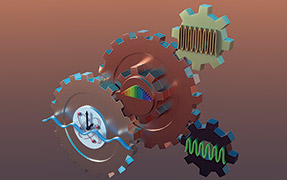Photon upconversion devices for long wavelength imaging
Charge-coupled-device (CCD) imaging devices have been used in many mass-market applications. However, they are limited to wavelengths shorter than about 1μm. We have been developing a new technology that uses photon upconversion from long to short wavelengths,1–6 particularly photon upconversion devices for wavelengths from 1.5–0.87μm. Here we summarize our research and development effort.
The end goal is to achieve an alternative technology for imaging in the 1.5μm region. So far, the basic idea is to integrate a 1.5μm detector with a 0.87μm light-emitting diode (LED) connected in series. The detected photocurrent drives the LED, thereby achieving upconversion. This idea is applicable to other wavelengths and has been employed in a variety of ways. For example, it was used to convert thermal infrared to near infrared using quantum-well infrared photodetectors and GaAs LEDs.7 In addition, integrating an InSb detector with an LED allowed upconversion of 5μm light.8 This approach also allows for producing pixelless imaging devices.9,10
It is well-known that GaAs-based material is an excellent choice for high-efficiency LEDs for wavelengths between 0.8 and 0.9μm, the range that the conventional CCD can ‘see’ well. However, it is difficult to make efficient photodetectors working in the range of 1.5μm using GaAs-based materials. A solution may be wafer fusion: an advanced processing technology for fabricating photonic devices.11 This enables integration of lattice-mismatched materials, which, if grown epitaxially, would generate a high density of dislocations causing severe device degradation. Already, wafer fusion has been applied to many semiconductors, enabling novel devices such as high-brightness transparent-substrate LEDs,12 long-wavelength vertical-cavity surface-emitting lasers (VCSELs),13 high-speed resonant-cavity photodetectors,14 and InGaAs hetero-interface photodetectors.15
Our 1.5 to 0.87μm upconversion devices consist of a standard p-i-n photodetector with a 1μm thick InGaAs light absorption layer grown on an InP substrate and an AlGaAs/GaAs LED grown on a GaAs substrate. GaAs was used for the LED active layer, having an emission wavelength of 0.87μm. After wafer fusion, the GaAs substrate was removed and mesa devices were fabricated. A schematic cross-section of a finished device is shown in Figure 1.

The 1.5μm ‘signal’ light was through the anti-reflection-coated backside and the 0.87μm emission was from the top. The working current density of the upconverters, typically in the range of 0.001 to 1A/cm2, is much lower than that for most LED applications. To optimize the emitter efficiency, we carried out experimental investigations on optimizing the p-doping concentration in the LED active region. Figure 1 shows the internal quantum efficiency of the optimal LED device with a doping concentration of 1.0 × 1018cm-3. We can see that the internal quantum efficiency is greater than 50% even at a very low injection level of 1.0 × 10-4A/cm2. The peak value of the internal quantum efficiency is close to 100%.

Soon after demonstrating upconversion, it was discovered that the output and input images were spatially correlated, and an imaging array consisting of a large number of pixels could be replaced by one large area device.9Figure 3 shows an example image.

We are working towards a practical photon upconversion device intended for imaging in the 1.5μm wavelength region. Future work will include optimizing the pixelless performance and improving the LED external efficiency. We are confident that, with further optimization, our approach will lead to a viable technology.
We thank R. Glew, D.L. Sivco, and A.Y. Cho for the growth of epitaxial wafers. This work was supported in part by the Department of National Defense's ‘Defense Research and Development Canada—Valcartier’ and the National Research Council's Genomics and Health Initiative program.



